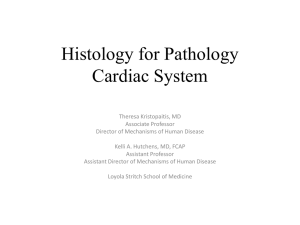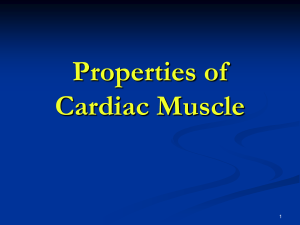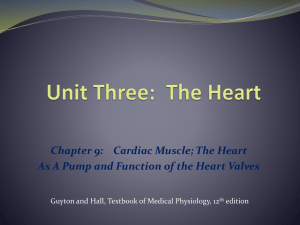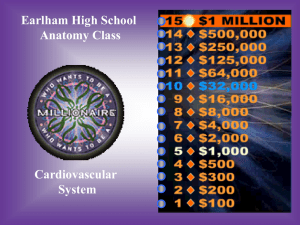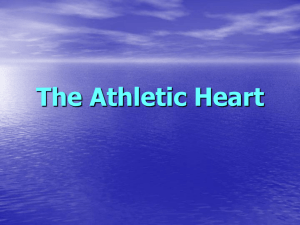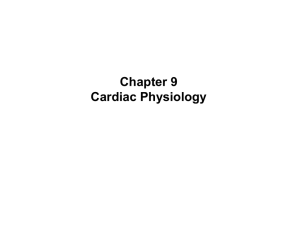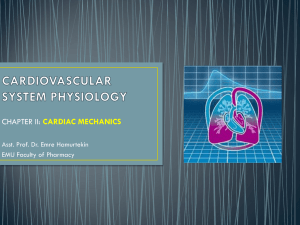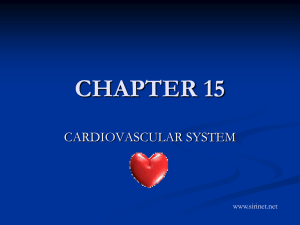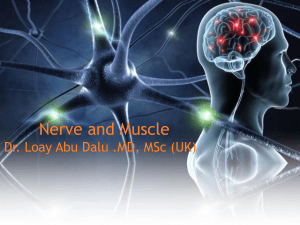CV_System_Heart_SP_09_st
advertisement
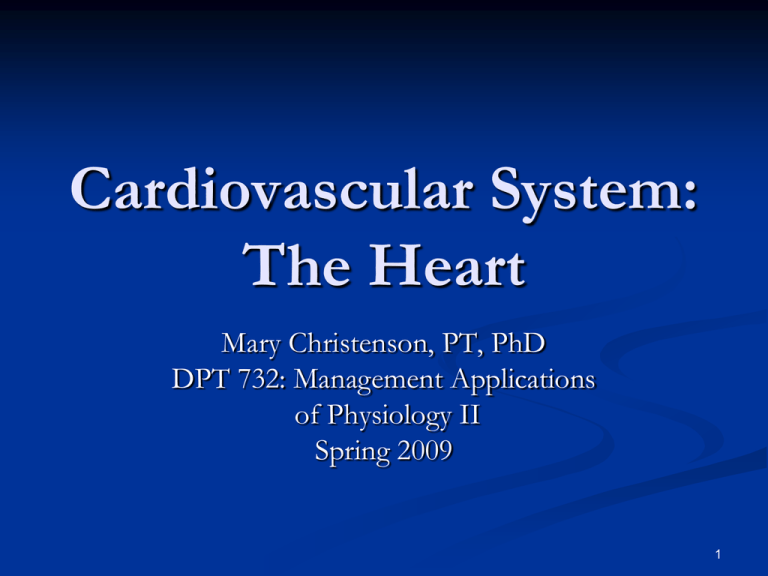
Cardiovascular System: The Heart Mary Christenson, PT, PhD DPT 732: Management Applications of Physiology II Spring 2009 1 Did You Know? Coronary circulation is the shortest circulation in the body “The longest cardiac arrest lasted four hours in the case of fisherman Jan Egil Refsdahl (Norway), who fell overboard off Bergen, Norway, on December 7, 1987. He was rushed to Haukeland Hospital after his body temperature fell to 75° F (24° C), and his heart stopped. He made a full recovery after being connected to a heart-lung machine.” http://www.amazon.com/Guinness-World-Records-2004/dp/product-description/0553587129 Objectives Describe the physiologic structure and function of the heart. Describe the systemic & pulmonary blood flow circuits of the CV system. Describe the coronary circulation and compare and contrast to the pulmonary/systemic circulation. Describe the function of the different types of cardiac muscle and the microanatomy (striated, intercalated discs, gap junctions) of each. Describe the energy requirements of the heart. Compare/contrast the intrinsic and extrinsic regulation of heart pumping. 3 Objectives (continued) Describe the cardiac cycle and compare and contrast the relationship between EKG tracing, heart sounds, atrial and ventricular pressure changes, atrial and ventricular volume changes, and valve actions that occur within the left chambers of the heart during a cardiac cycle. Describe the specialized excitatory and conductive system of the heart. Describe the cellular mechanisms of pacemaker potential and cardiac muscle contraction, and compare with action potentials and skeletal muscle contraction. Describe the characteristics and principle features of a normal EKG (waves, segments, complexes, polarization, depolarization, repolarization). 4 Heart Anatomy: A Review Functional anatomy 5 Heart Anatomy: A Review External anatomy view Membrane coverings Heart wall Vessels entering/exiting Blood flow circuits: arteries versus veins Pulmonary circuit Systemic circuit Coronary arteries 6 Pericardium 7 Heart Wall 8 Heart Anatomy: A Review Internal anatomy Chambers Structures 9 10 Coronary Blood Flow 11 Systemic & Pulmonary Blood Flow Cardiac Muscle & Microanatomy Muscle Atrial muscle Ventricular muscle Specialized excitatory and conductive muscle fibers Muscle cells Intercalated discs Gap junctions 13 14 Electron Micrograph Cell Connections Compare/Contrast Cardiac and Skeletal Mechanism of Contraction Similarities Striated – myosin/actin mechanism T-tubule mechanism – acting on sarcoplasmic reticulum Differences T-tubule mechanism – direct diffusion of Ca++ Action potential Cardiac muscle “plateau” Strength of contraction 17 Conduction Ability of cardiac mm to depolarize and contract is intrinsic Intrinsic conduction system Components Sinus node = sinoatrial/S-A node Internodal pathways A-V node A-V bundle Left and right bundle branches of Purkinje fibers 18 Intrinsic Conduction System 19 Features of the S-A Node Smaller diameter muscle fibers Almost no contractile muscle fibers Connect directly with atrial muscle (mm) fibers Cell membranes naturally “leaky” to Na+ and Ca++ ions – therefore, less negative resting membrane potential than other cardiac mm cells Fast Na+ channels, at less negative potential, “inactivated” Self-excitation 21 22 EKG Electrical impulses passing through the heart also spread into adjacent tissues and some to the surface of the body Can be captured at surface of the body using electrodes 23 EKG Tracing 24 Cardiac Cycle Events that occur from the beginning of one heartbeat to the beginning of the next Chamber and vessel blood volume changes Chamber and vessel blood pressures changes Electrical activity noted Heart sounds occur Valves open and close Describe the relationships between the events 25 Cardiac cycle Consists of: Diastole: period of relaxation; heart filling with blood Systole: contraction period, heart ejects blood What would be: the definition of end-diastolic volume (EDV)? the definition of end-systolic volume (ESV)? Ejection fraction: fraction of EDV ejected 26 Guyton Cardiac Cycle 28 Relationship of Cardiac Cycle to ECG P wave: spread of depolarization through atrial tissue followed by contraction - atrial pressure QRS complex: spread of depolarization through ventricular tissue followed by contraction ventricular pressure T wave: repolarization of the ventricles which represents ventricular relaxation 29 Atria as “Pumps” Majority of returning venous blood flows directly from atrium to ventricle Atrial contraction usually causes an additional 20% ventricle filling; “primer pump” Atrial function “unnecessary” except during vigorous exercise Atrial pressure changes 30 Ventricles as “Pumps” Ventricular filling: after systole, A-V valves open due to build up of pressure in atria during systole: period of rapid filling of ventricles followed by 2 additional phases Period of Isovolumic Contraction Period of Ejection Period of Isovolumic Relaxation 31 Preload and Afterload Preload – End-diastolic pressure when the ventricle is filled; amount of tension on the muscle when it begins to contract Afterload – pressure in the artery leading from the ventricle; load against which the muscle exerts its contractile force Heart and/or circulation pathology can severely alter preload and/or afterload 32 Chemical Energy Requirements for Cardiac Contraction Great dependency/almost exclusive reliance on O2 for energy metabolism (oxidative) compared to skeletal muscle which can utilize anaerobic metabolic sources as well Energy derived primarily from oxidative metabolism of fatty acids (food of choice: primary oxidative nutrient source), some lactate, glucose Cardiac muscle can also use lactic acid generated by skeletal muscle activity 34 Intrinsic Regulation of the Cardiac Pump Heart pumps 4-6 liters of blood/minute @ rest Frank-Starling Mechanism Heart automatically pumps incoming blood; i.e., amount of blood pumped determined primarily by rate of blood flow into heart As cardiac muscle is stretched with returning blood volume, approach optimal length of actin and myosin fibers for contraction Stretch of R atrial wall Increase HR by 10-20% 35 Extrinsic Regulation of the Cardiac Pump (ANS) Sympathetic Nervous System (SNS) Norepinephrine released by sympathetic nerve fibers in response to stressors such as fright, anxiety, or exercise; threshold reached more quickly Increase cardiac output (CO) Pacemaker fires more rapidly Enhanced mm contractility Effects of inhibiting SNS Extrinsic Regulation of the Cardiac Pump (ANS) Parasympathetic Nervous System Reduces HR when stressors removed Acetylcholine hyperpolarizes membranes of cells – opens K+ channels PNS fibers in Vagus nerves to heart can decrease CO Primarily affects HR rather than contractility Autonomic Innervation of the Heart 38 Resting Conditions S-A node receives impulses from both autonomic divisions continuously Dominant influence is inhibitory – heart said to exhibit “vagal tone” “Disconnect” vagal nerves = HR increases ~25 bpm almost immediately

